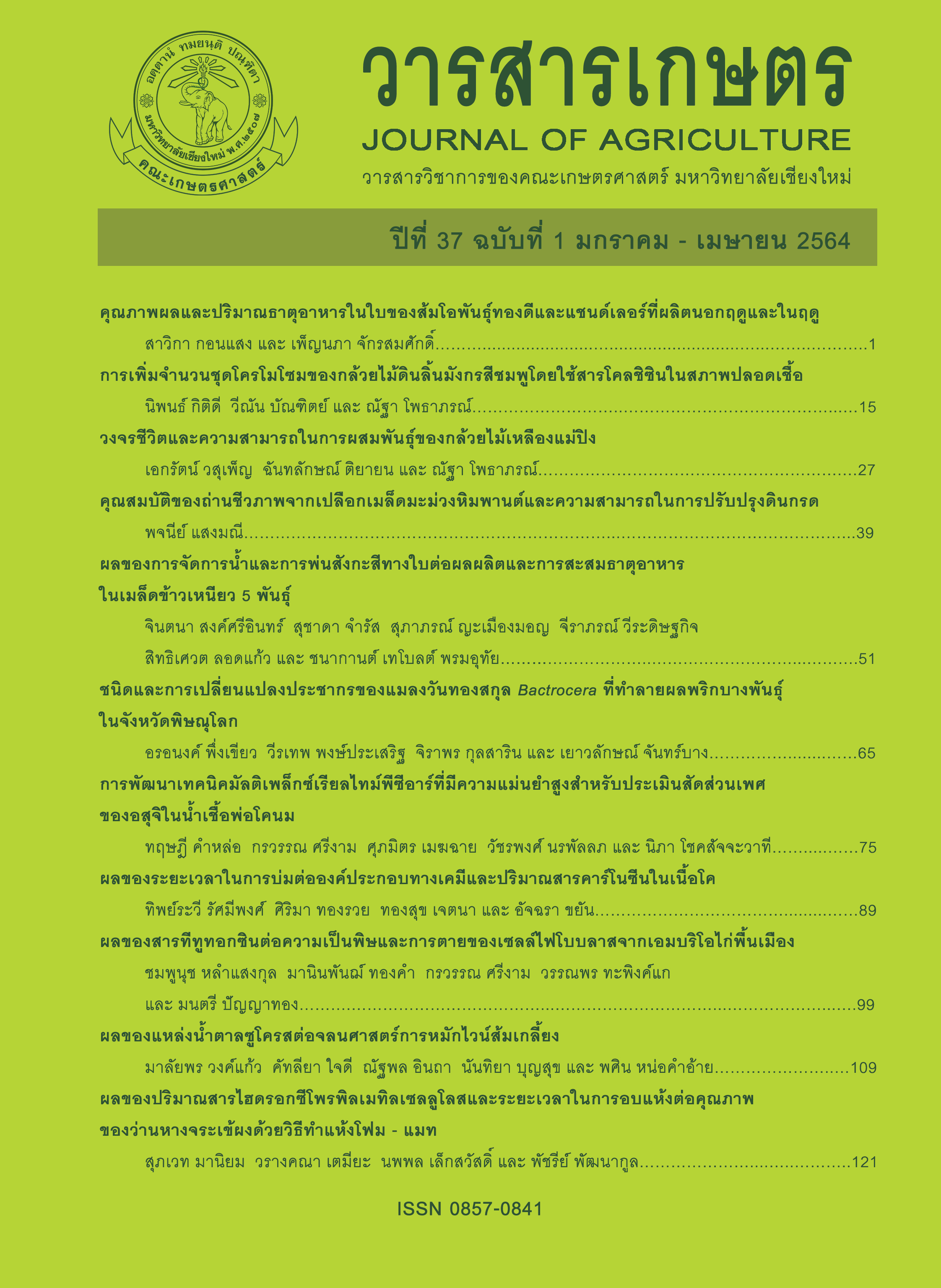คุณสมบัติของถ่านชีวภาพจากเปลือกเมล็ดมะม่วงหิมพานต์และความสามารถในการปรับปรุงดินกรด
Main Article Content
บทคัดย่อ
จังหวัดอุตรดิตถ์เป็นแหล่งเพาะปลูกมะม่วงหิมพานต์แหล่งใหญ่ที่สุดของประเทศไทย มีผลผลิตเมล็ดมะม่วงหิมพานต์โดยเฉลี่ย 5,000 ตันต่อปี ภายหลังจากกระบวนการกะเทาะเมล็ดจะมีเปลือกหุ้มเมล็ดมะม่วงหิมพานต์เป็นของเสียชุมชนประมาณ 3,500 - 4,000 ตัน ปัจจุบันได้มีการกำจัดโดยการขายออกนอกพื้นที่หรือมีการบีบอัดเอาน้ำมัน (cashew nut shell liquid, CNSL) เพื่อนำไปใช้ในเชิงอุตสาหกรรม กระบวนการดังกล่าวยังคงเหลือกากของเปลือกหุ้มเมล็ดมะม่วงหิมพานต์ที่สร้างปัญหาขยะชุมชนที่จำเป็นต้องหาแนวทางการนำไปใช้ประโยชน์ งานวิจัยนี้จึงได้มีการนำเปลือกหุ้มเมล็ดมะม่วงหิมพานต์มาเป็นวัตถุดิบในการทำถ่านชีวภาพ (cashew nut shell biochar, CNSC) และศึกษาการใช้ประโยชน์ทางการเกษตร เช่น สารปรับปรุงดิน และแหล่งธาตุอาหารพืช ดังนั้นจึงทำการทดสอบคุณสมบัติทางเคมี ผลของการใช้ CNSC ต่อการเปลี่ยนแปลงค่า pH, EC และการปลดปล่อยธาตุอาหารพืช โดยใช้ปูนขาวและยิปซัมในการเปรียบเทียบ ผลการศึกษา พบว่า CNSC มีคุณสมบัติเป็นด่างจัดโดยมีค่า pH 10.3 และมีคาร์บอนที่เสถียรเป็นองค์ประกอบหลัก (57.71%) มีโพแทสเซียมเป็นธาตุอาหารที่พบมากที่สุดคือ 3.24 % ประสิทธิภาพในการปรับค่า pH ของ CNSC น้อยกว่าปูนขาวพิจารณาจากอัตราการใช้ CNSC เพื่อการปรับค่า pH ของดินที่อยู่ในช่วง 10 - 50 เท่าของ LR โดยมีโพแทสเซียมซึ่งเป็นแคทไอออนที่เป็นด่างเป็นปัจจัยสำคัญที่ทำให้ความเป็นกรดในดินลดลง นอกจากนี้ การใส่ CNSC ยังช่วยเพิ่มความเป็นประโยชน์ของฟอสฟอรัสและโพแทสเซียมที่แลกเปลี่ยนได้โดยไม่ส่งผลต่อค่าการนำไฟฟ้า
Article Details
เอกสารอ้างอิง
Andonaba, J.-B., S.S. Lompo, V. Ouédraogo, F. Ouédraogo, M.S. Ouédraogo, I. Konaté, B. Diallo and A. Traoré. 2017. Skin damage and aesthetic disadvantage observed in women in the hand craft shelling chain of cashew nuts in a factory to Bobo-Dioulasso, Burkina Faso. Journal of Cosmetics, Dermatological Sciences and Applications 7: 211-220.
Chintala, R., J. Mollinedo, T.E. Schumacher, D.D. Malo and J.L. Julson. 2014. Effect of biochar on chemical properties of acidic soil. Archives of Agronomy and Soil Science 60(3): 393-404.
Erich, M.S. and T. Ohno. 1992. Titrimetric determination of calcium carbonate equivalence of wood ash. Analyst 117(6): 993-995.
Kaweewong, J. 2018. Using flue gas desulfurization (FGD) gypsum, by-product of coal-fired power plants in agriculture. King Mongkut's Agricultural Journal 36(1): 161-172. (in Thai)
Kaweewong, J., J. Meesumlee and K. Sompuk. 2018. Effects of flue gas desulfurization gypsum on selected soil properties and rice growth cv. Sanpatong 1. The Golden Teak: Science and Technology Journal 5(2): 23-35. (in Thai)
Klaichom, P., G. Intuwong and P. Nathiang. 2017. Participatory technology transfer of CNSL oil extraction for adding value to wasted cashew nut shell from food processing. pp. 271-279. In: Proceedings of Thailand Research Symposium, Bangkok. (in Thai)
Kookana, R.S., A.K. Sarmah, L. van Zwieten, E. Krull and B. Singh. 2011. Biochar application to soil: agronomic and environmental benefits and unintended consequences. Advances in Agronomy 112: 103-143.
Leksungsoen, P., W. Wisawapipat and D. Ketrot. 2017. Impacts of rice husk biochar on solubility of micronutrients and rice growth cultivated in a calcareous soil. Songklanakarin Journal of Plant Science 4(3): 65-74. (in Thai)
Manaonok, J., S. Gonkhamdee, K. Dejbhimon, W.K. Polpinit and D. Jothiyangkoon. 2017. Biochar: its effect on soil properties and growth of wet-direct seeded rice (a pot trial). Khon Kaen Agriculture Journal 45(2): 209-220. (in Thai)
Novotny, E.H., C.M.B. de Freitas Maia, M.T. de Melo Carvalho and B.E. Madari. 2015. Biochar: Pyrogenic carbon for agricultural use - A critical review. Revista Brasileira de Ciência do Solo. 39(2): 321-344.
Pearaksa, P. and S. Saeng-ngam. 2018. Effect of biochar application on growth and efficiency of photosynthesis of pepper (Capsicum annuum L. cv. Super Hot) under acid soil. Khon Kaen Agriculture Journal 46(Suppl. 1): 338-343. (in Thai)
Raksabo, T., W. Wisawapipat, S. Aramrak and N. Chittamart. 2018. Effects of rice husk ash and biochar on phosphorus fractions in an acid sulfate paddy soil and rice growth. Songklanakarin Journal of Plant Science 5(4): 85-99.
Sangmanee, P., A. Bhromsiri and H. Tamura. 2011. Plant nutrient status of soil in durian and longkong orchards under agroforestry system in Uttaradit province. Journal of Agriculture 27(2): 197-208. (in Thai)
Sangmanee, P., V. Somniyam and P. Chaikla. 2018. Development of plant analysis procedure to assist plant nutrition management for durian. Final report. The Thailand Research Fund, Bangkok. 86 p. (in Thai)
Siriwal, N. 2011. Improving soil quality with gypsum for agricultural sustainability. Rajamangala University of Technology Phra Nakhon Research Journal 5(1): 118-126.
Suwanwong, S. 2001. Method of Plant Analysis. Kasetsart University Press, Bangkok. 141 p. (in Thai)
Therajindakajorn, P. 2009. Handbook of Soil Chemical Analysis. Department of Plant Science and Agricultural Resources, Faculty of Agriculture, Khon Kaen University, Khon Kaen. 169 p. (in Thai)
Uttaradit Provincial Agriculture and Cooperatives Office. 2019. Agricultural data of Uttaradit province. (Online). Available: https://www. opsmoac.go.th/uttaradit-home (December 10, 2019). (in Thai)
Walkley, A. and I.A. Black. 1934. An examination of the Degtjareff method for determining soil organic matter, and a proposed modification of the chromic acid titration method. Soil Science 37(1): 29 - 38.
Wang, S.J., Q. Chen, Y. Li, Y.Q. Zhuo and L.Z. Xu. 2017. Research on saline-alkali soil amelioration with FGD gypsum. Resources, Conservation and Recycling 121: 82-92.
Watts, D.B. and W.A. Dick. 2014. Sustainable uses of FGD gypsum in agricultural systems: introduction. Journal of Environmental Quality 43(1): 246-252.


